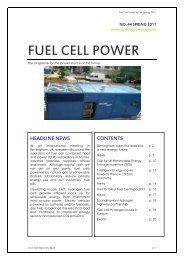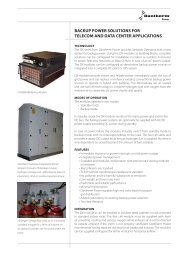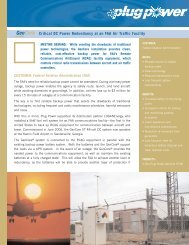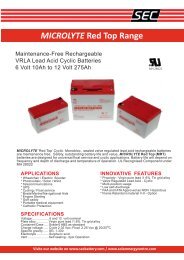The adoption curve: what can we learn from ... - Fuel Cell Markets
The adoption curve: what can we learn from ... - Fuel Cell Markets
The adoption curve: what can we learn from ... - Fuel Cell Markets
Create successful ePaper yourself
Turn your PDF publications into a flip-book with our unique Google optimized e-Paper software.
FUEL CELL FOCUS<br />
<strong>The</strong> <strong>adoption</strong> <strong>curve</strong>: <strong>what</strong> <strong>can</strong><br />
<strong>we</strong> <strong>learn</strong> <strong>from</strong> microelectronics?<br />
Like the microelectronics business before it, the fuel cell industry is<br />
confident it is progressing along a viable path to market <strong>adoption</strong>.<br />
Mark Sperry, Plug Po<strong>we</strong>r, Latham, NY, USA<br />
Many other technologies<br />
have confronted the state<br />
of affairs currently being<br />
faced by the fuel cell<br />
industry. Consider the microelectronics<br />
landscape just three decades<br />
ago: the technology held immense promise; the<br />
hype had outpaced the reality; mass commercialisation<br />
could not occur without substantially<br />
reduced costs; research was moving in many<br />
different directions. And look <strong>what</strong> happened.<br />
This track record raises hopes for the future<br />
of fuel cells. Indeed, as with microelectronics,<br />
an <strong>adoption</strong> <strong>curve</strong> has emerged to make<br />
commercialisation practical while advancing<br />
innovation. Already, industry leaders have made<br />
progress along that <strong>adoption</strong> <strong>curve</strong>. With the<br />
presence of certain drivers, further progress <strong>can</strong><br />
point the way to a more stable blend of grid and<br />
distributed generation in the future.<br />
<strong>Fuel</strong> cells today<br />
Both industries began with grand projections.<br />
As recently as the late 1990s "a fuel cell in every<br />
home" seemed, to some, achievable in a few<br />
short years. Today, in place of that dream, a<br />
melange of research directions has emerged -<br />
many pursued by global organisations, and<br />
many likely to contribute to a solid foundation<br />
for future commercialisation.<br />
Supporting such efforts is a signifi<strong>can</strong>t push<br />
<strong>from</strong> national governments, which have provided<br />
research funding, tax credits and other<br />
initiatives to stimulate innovation. In the USA,<br />
the Energy Policy Act of 2005 featured several<br />
provisions friendly to fuel cells, including a 30%<br />
tax credit (up to $1000 per kilowatt)<br />
for the purchase of fuel cells used in<br />
residential or commercial applications<br />
and $3.7 billion for hydrogen and fuel<br />
cell R&D over 10 years. Japan has set<br />
ambitious commercialisation targets<br />
while pursuing fleet demonstrations<br />
and considering large subsidies for residential<br />
installation. Canada and the<br />
European Union have taken substantial<br />
measures. Clearly, key players have<br />
thrown their considerable resources<br />
behind fuel cell development. Those<br />
resources are critical to overcoming,<br />
among other things, a daunting cost<br />
challenge.<br />
Reversing the cost<br />
cycle<br />
That challenge involves a vicious cycle of cost<br />
and market viability. To make fuel cells commercially<br />
viable, manufacturers must lo<strong>we</strong>r unit<br />
costs. One path to lo<strong>we</strong>r unit costs is higher<br />
manufacturing volume, which creates<br />
economies of production. Higher volume, in<br />
turn, <strong>can</strong> only occur with demand <strong>from</strong> a critical<br />
mass of customers. Yet many customers <strong>can</strong>not<br />
invest in fuel cells because of high unit costs.<br />
Again, microelectronics provides a hopeful<br />
parallel. Mainframes worked <strong>we</strong>ll for large enterprises<br />
but <strong>we</strong>re completely impractical for<br />
the consumer market. In response, the microelectronics<br />
industry transformed the vicious<br />
cycle into one of constant innovation, lo<strong>we</strong>r<br />
costs, smaller size and massive market acceptance.<br />
Can fuel cells follow a similar path?<br />
<strong>Fuel</strong> cell <strong>adoption</strong> <strong>curve</strong><br />
Plug Po<strong>we</strong>r’s GenCore back up po<strong>we</strong>r fuel cell unit<br />
<strong>The</strong> <strong>curve</strong> takes shape<br />
It appears that they <strong>can</strong>. <strong>Fuel</strong> cell developers<br />
are moving steadily down an <strong>adoption</strong> <strong>curve</strong><br />
that has taken shape over the past few years.<br />
<strong>The</strong> progress, and prognosis, look like this:<br />
• Early adopters. Early adopters of fuel cell<br />
technology have emerged in several areas.<br />
Portable fuel cells have found their way into<br />
industrial applications; companies are<br />
developing uses in laptop computers and<br />
other consumer electronics. On the<br />
stationary front, the Long Island Po<strong>we</strong>r<br />
Authority has invested heavily in fuel cells<br />
to supplement its grid during peak load<br />
times. Las Vegas, Chicago and other cities<br />
have deployed buses po<strong>we</strong>red by fuel cells.<br />
• Backup po<strong>we</strong>r. Even as early adopters continue<br />
their exploration, an urgent need in<br />
telecommunications has sparked a new<br />
commercial application.<br />
Faced with burgeoning consumer demand<br />
and severe cost constraints, telecom<br />
network planners are scrambling to optimise<br />
plant infrastructure, including backup<br />
po<strong>we</strong>r. In this backup po<strong>we</strong>r market, fuel<br />
cells are beginning to find a niche. <strong>The</strong>ir light<br />
<strong>we</strong>ight, quiet operation, zero emissions<br />
(when operating on hydrogen) and peak performance<br />
over a broad temperature range<br />
have made them an excellent fit for backup<br />
po<strong>we</strong>r applications in the outside plant.<br />
Such a use <strong>can</strong> easily branch to similar applications,<br />
such as uninterruptible po<strong>we</strong>r<br />
supply (UPS).<br />
This trend <strong>can</strong> be seen in a place observers<br />
may have overlooked: South Africa.<br />
16 Modern Po<strong>we</strong>r Systems March 2006 www.modernpo<strong>we</strong>rsystems.com
In December 2005, the World Bank's<br />
International Finance Corporation (IFC)<br />
awarded $3 million to IST Holdings and Plug<br />
Po<strong>we</strong>r, which will install 400 fuel cells<br />
throughout South Africa over three years. If<br />
successful, this venture could serve as a<br />
model for supplying po<strong>we</strong>r needs in developing<br />
countries.<br />
• Stationary fuel cells. As field data <strong>from</strong> these<br />
applications inform further innovation - driving<br />
costs and prices down - stationary fuel<br />
cells should take hold in the prime-po<strong>we</strong>r<br />
market. As with backup po<strong>we</strong>r, the first use<br />
will come in remote telecom installations,<br />
and this application will enable fuel cell<br />
manufacturers to begin field-testing other<br />
uses of their systems.<br />
From remote areas, the <strong>adoption</strong> <strong>curve</strong><br />
takes us inward. Further innovations and accompanying<br />
price reductions will make stationary<br />
fuel cells a po<strong>we</strong>r option for<br />
commercial, industrial and eventually residential<br />
customers. In most of these cases,<br />
ho<strong>we</strong>ver, fuel cells will undoubtedly serve<br />
to complement the grid.<br />
• Automotive applications. Even today, automotive<br />
fuel cells are finding use in the marketplace:<br />
• Since 2002, three major automakers<br />
(Honda, Toyota and Nissan) have leased<br />
fuel cell vehicles.<br />
• Honda actively uses a fleet of fuel cellpo<strong>we</strong>red<br />
vehicles in California.<br />
• Utility vehicles and forklift trucks are undergoing<br />
trial runs in such places as<br />
Munich airport.<br />
In moving towards true market viability,<br />
automotive applications will draw a great<br />
deal <strong>from</strong> the lessons <strong>learn</strong>ed in stationary<br />
fuel cell development. <strong>The</strong> core technology<br />
for fuel cells is currently under widespread<br />
testing in stationary field trials; the cost reductions<br />
achieved by manufacturers of stationary<br />
systems will translate to automotive<br />
applications. Even with this support, ho<strong>we</strong>ver,<br />
automotive makers suggest that it will<br />
be early next decade before fuel cell vehicles<br />
are commercially available, and the lack<br />
of hydrogen infrastructure could push that<br />
back further.<br />
Moving forward<br />
Ideally, fuel cells would evolve seamlessly<br />
<strong>from</strong> a positive cycle of innovation, lo<strong>we</strong>r unit<br />
cost, higher sales and more funding for more<br />
DC<br />
transfer<br />
switch<br />
DC buss<br />
(120 volts DC)<br />
innovation. In reality,<br />
fuel cell development<br />
requires certain drivers,<br />
especially at<br />
transitions bet<strong>we</strong>en<br />
stages. Several players<br />
are <strong>we</strong>ll positioned to<br />
provide those drivers.<br />
• <strong>The</strong> role of government.<br />
National and<br />
state governments<br />
<strong>can</strong> build on their already<br />
substantial efforts.<br />
As early<br />
adopters, they could<br />
further mitigate the<br />
vicious cycle of cost<br />
and volume by po<strong>we</strong>ring<br />
more of their<br />
operations through<br />
fuel cells. <strong>The</strong><br />
Renewable Portfolio<br />
Standards of some<br />
US states include<br />
fuel cells as a renewable<br />
resource; other<br />
governments would<br />
help greatly by following<br />
that lead.<br />
Just as important,<br />
GenCore, Oneida installation<br />
governments could work to remove com- director, outlined key components (on his<br />
petitive barriers, especially in interconnec- own initiative) late in 2004. With a roadmap<br />
tion standards. A combination of lengthy in hand, industry players could direct their<br />
application processes and high fees have research and production energies to the<br />
made it cost-prohibitive for fuel cells to op- applications with highest near-term potenerate<br />
in many areas. <strong>The</strong> creation of an intial, and early success in these ventures<br />
ternational standard – perhaps along the would spur the industry to longer-term<br />
lines of IEEE 1547 – could promote cross- accomplishments.<br />
border commerce and instill confidence • Consortia and collaborations. By forming<br />
that the grid is being preserved.<br />
consortia like International Sematech to<br />
Government aside, many drivers <strong>can</strong> conduct pre-competitive research, the<br />
come <strong>from</strong> within the fuel cell industry. <strong>The</strong> semiconductor industry has driven innova-<br />
research conducted by Fortune 100 comtion while allowing consortia members to<br />
panies provides a po<strong>we</strong>rful force for mov- direct resources toward more bottom-line<br />
ing fuel cells toward commercialisation. concerns. <strong>The</strong> same could easily happen<br />
Now the challenge is to co-ordinate these with fuel cells, given the number of com-<br />
efforts, and those of others, in a way that acpanies in the field and the collective<br />
celerates development.<br />
research capability they represent.<br />
• <strong>The</strong> roadmap to success. In this, a roadmap • Going global. <strong>The</strong> initiatives in South Africa<br />
<strong>from</strong> a respected source would serve the represent a key step towards a global mar-<br />
same function as a corporate strategic plan. ket. So does the agenda, signed by fuel cell<br />
Established industry organisations, like the promotional bodies <strong>from</strong> around the world,<br />
US <strong>Fuel</strong> <strong>Cell</strong> Council, command sufficient to initiate collaboration on several fronts.<br />
respect to initiate a roadmap; indeed, From here, the industry <strong>can</strong> create cross-<br />
Robert Rose, the council's executive border organisations to enhance cooperation,<br />
engage in international advocacy, help<br />
other nations develop viable standards and<br />
encourage the opening of markets.<br />
GenCore connection scheme for a telecommunications application<br />
GenCore GenCore<br />
Control wire<br />
PBX<br />
(load)<br />
FUEL CELL FOCUS<br />
APC<br />
Symmetra<br />
(UPS device)<br />
AC<br />
input<br />
(120/208 volts AC)<br />
AC<br />
transfer<br />
switch<br />
<strong>The</strong> value of patience<br />
Fortunately, all of this has happened before –<br />
with great success. Look again at the microelectronics<br />
industry: it has developed standards<br />
to drive volume and ensure market<br />
readiness, advocated before government for<br />
research funding and purchase programmes,<br />
and expanded into a global market.<br />
It has also taught the value of patience. In an<br />
industry that most equate with speed, personal<br />
computers took 15 years just to reach 25%<br />
commercialisation. <strong>The</strong> lesson here is to maintain<br />
focus without expecting too much too fast.<br />
All these trends contain specific lessons for<br />
fuel cell development. If industry players take<br />
these lessons to heart, they could do much to<br />
facilitate the success of fuel cells in the<br />
decades to come.<br />
MPS<br />
www.modernpo<strong>we</strong>rsystems.com March 2006 Modern Po<strong>we</strong>r Systems 17
















